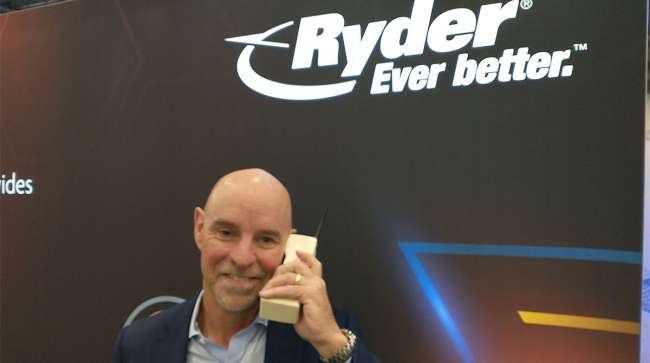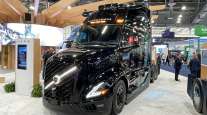Staff Reporter
BET Evolution at Same Point as Brick Cellphones: Sanchez

[Stay on top of transportation news: Get TTNews in your inbox.]
Battery-electric trucks have arrived at an evolutionary point not dissimilar to the one that brick-style cellphones occupied in the 1980s, Ryder System Inc. CEO Robert Sanchez told attendees of the ACT Expo 2024 conference in Las Vegas May 22.
While waving an example of the 2½-pound Motorola DynaTAC 8000X “brick” phone that was a breakthrough in its time, Sanchez said the current selection of BETs must take technological leaps similar to those that carried mobile devices from bricks to smartphones.
“We need an inflection point — that critical technological breakthrough that serves as a catalyst for mass adoption of new technology,” Sanchez said during a speech. “Historically, inflection points — such as the industrial revolution, the introduction of the assembly line, and the dot-com boom — transformed societies, economies, and cultures, and ultimately, have led to new opportunities. It has been our experience at Ryder that when a new technology is ready for the market, people and businesses see the benefits and mass adoption follows.”
He pointed back to those early cellphones as an example.
“We were not forced back then to buy a brick,” Sanchez told Transport Topics in an interview on the sidelines of the conference. “You allowed the technology to take its course. Nobody knows what an inflection point is going to be until you have one.”
Sanchez believes the technology inflection point for battery-electric trucks will likely involve higher battery capacity, longer range and lower weight, he added. At the moment, however, Ryder data shows battery-electric trucks are economically viable only in a few circumstances.
Electric Vehicle Total Cost to Transport Analysis
Analysis released by the leasing and logistics specialist May 8 indicated the business case for swapping a diesel or gasoline van or truck for an EV is questionable for much of the trucking industry. Ryder warned in its “Charged Logistics: The Cost of Electric Vehicle Conversion for U.S. Commercial Fleets” study that regulatory mandates to introduce EVs before enough infrastructure is in place and vehicle costs decrease considerably could hurt U.S. supply chains and the trucking sector. But, Sanchez was quick to note that the company supports clean energy options that are viable for fleets.
“To be clear, Ryder is in support of any low- or zero-emission technology that can help our customers to succeed,” he told the ACT crowd. “Today, we deploy EVs with our customers when and where it makes sense. We work with multiple EV manufacturers and charging infrastructure providers to pilot and provide customized EV solutions, and we act as an extended research and development arm for our suppliers and customers.”
To that end, he explained how the company works with customers to find viable applications for EVs in their operations.
“We introduced RyderElectric+ last May at this very event and it provides everything from electrification advisers to vehicles, charging, telematics and maintenance. But, even with a solution designed to take all the complexity out of electrification, we are not seeing significant adoption,” he said.
Robby Hamby of Bridgestone Americas and Ken Eggen of Wolf River Express share how fleets should acquire the right tire monitoring tools for data collection. Tune in above or by going to RoadSigns.ttnews.com.
Ryder identified its initial customers Dec. 5 for RyderElectric+. The first two companies to be publicly revealed were Pompano Beach, Fla.-based Land ‘N’ Sea Distributing, a marine and recreational vehicle parts distributor, and Servientrega International, a Bogota, Colombia-based parcel logistics carrier with operations in Ryder’s hometown of Miami.
Ryder Supply Chain Solutions ranks No. 10 on the Transport Topics Top 100 list of the largest logistics companies in North America and No. 9 among TT’s 100 largest for-hire carriers.
“Like the cellphone, we need electric vehicle costs to come down, and we need smaller, lighter and more powerful battery technology to improve range and capacity. And, like cellular networks, we need a nationwide infrastructure. We need the fastest applicable chargers available where professional drivers can conveniently charge their trucks, get a bite to eat, and rest at the same time,” Sanchez told conference attendees.
The changes needed to bring that nationwide network, he said, would be:
- Advancing battery technology to address payload and range limitations;
- Reducing the vehicle cost; and
- Building out sufficient charging networks and related power grids.
“There’s still hurdles and barriers to the transition,” Sanchez told TT. “In commercial vehicles, it has to make economic sense.” And one cost variable that could help expedite mass adoption is an evolution in battery chemistry.
Want more news? Listen to today's daily briefing above or go here for more info
“Battery technology continues to evolve,” he said. With so many smart people looking at the battery-electric conundrum, the breakthrough is likely to come about, he said. “When you find the solution, it will go global,” he told TT.
Sanchez also stressed that it’s not up to industry alone.
“Governments need to continue to push research and development,” he said.“Is this really a Manhattan Project type of situation where you bring the brightest minds together? No one is really doing that.”
Sanchez added, “We have a history of solving problems. It is just getting there.”





